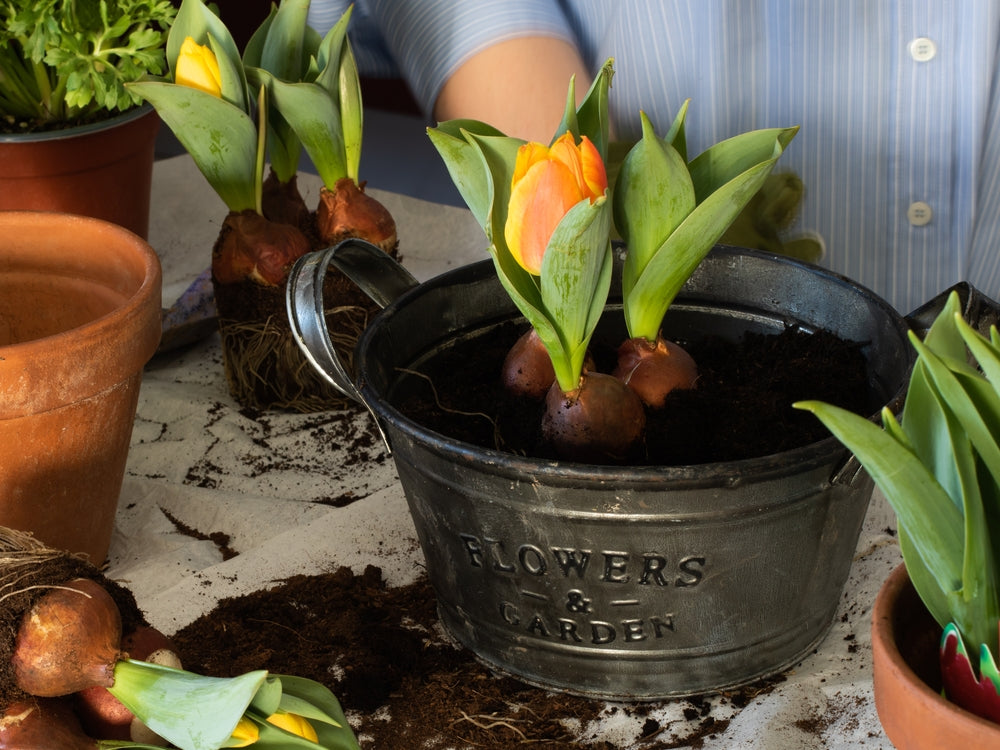
Speeding up the season – chilling and forcing flower bulbs
During the long cold winter months nature seems very quiet. The stillness has its own beauty, but it’s very different from the birds and blooms of spring. But looks can be deceiving because in the cold ground something very important is happening – the flower bulbs you planted in fall are undergoing a crucial process called chilling, during which a chemical change happens that prepares them for the growing season ahead. In a way, you can compare planting bulbs in fall to putting them to bed, with winter as their necessary sleep, from which they wake up newly energized on a sunny spring morning.
When is the cooling period for flower bulbs?
The need for a cold period is one of the main characteristics of (most) flower bulbs. But nowhere is it written that this cold period needs to happen when it’s cold outside as well. If you have a fridge or an unheated basement or garage, you can imitate the chilling process and enjoy flower bulbs in full bloom pretty much whenever you want.
What is forcing flower bulbs?
Although the lengths of the chilling periods required differ per flower bulb, the basic process is (almost) always the same: recreate the wintery underground conditions by storing the bulbs in a fridge, basement or cellar at around 40 F. After the allotted cooling time is over you bring the bulbs into a cool room (<65F) with lots of bright natural light, and after about 2-5 weeks you’ll have pots full of blooming flower bulbs. There are two kinds of forcing: pot & soil or glass & water, and below we’ll discuss the ins and outs of both of them.
How to chill flower bulbs in a pot or container
For chilling in pot & soil, you’ll need well-draining pots that are spacious enough to allow for 3-4” of roots growing under the bulbs. Fill three quarters of your pot with potting soil that you’ve mixed with water to form a moist (but not soggy) mixture. Place the bulbs on the soil with their pointy ends up, as many bulbs as you can fit in without the bulbs touching. Small bulbs should be covered completely while larger bulbs should be covered up to their necks with the tips remaining exposed. Water very well, put the whole pot into a paper bag and place it in a fridge or dark, cold cellar or basement with a steady temperature of around 40 F. If you use a fridge to chill your bulbs, make sure not to store them together with fruit, as the fumes from the fruit will impede the development of the blooms in spring. Check the soil weekly and water thoroughly when it’s dry to the touch.
How do I know when the cooling period is over?
Chilling time is all about the development of strong, healthy roots, and they should be the indicator of the end of the chilling period, not the green shoots on top. If you see fleshy white roots poking through the bottom holes of your pot, it’s time to transfer the bulbs to a bright window in a cool room (<65F), where they will bloom after 2-5 weeks. During this period, the bulbs should be watered once a week, and every other day once they’re blooming.
How to chill flower bulbs in glass and water
To force bulbs in glass & water, you chill loose bulbs in a paper bag in a fridge (again, not together with fruit) or dark and cold basement or garage. After the chilling period is over, you take the bulbs out and place them with their pointy ends up on top of a layer of pebbles or marbles on the bottom of your glass container. Add water to just under the bottom of the bulbs, but not touching, and place the container in a cool room with bright but indirect light. You might need to add more water every few days to keep it at the right level.
How do I know when flower bulbs are ready after chilling?
The nice thing about this method is that you can watch the roots form. It’s also an ideal method for forcing bulbs that don’t need a cooling period like paperwhites. Once you see leaves and stems forming, you move the container to an area with even more light (like a windowsill), where the temperature is at least 65F. There the flowers will bloom after 1-2 weeks.
Will forced flower bulbs bloom again?
Bulbs that have been forced this way, even perennials, will mostly not give you a second season, so it’s best to just toss them on your compost heap and order new bulbs for your next forcing session.
What is the cooling period for flower bulbs?
Muscari: 6-8 weeks
Anemone: 8-10 weeks
Crocus: 8-10 weeks
Leucojum: 8-10 weeks
Chionodoxa: 10-12 weeks
Snowdrops: 10-12 weeks
Dwarf Irises: 10-12 weeks
Siberian Squill : 10-12 weeks
Hyacinths: 10-12 weeks
Tulips: 12-16 weeks
Daffodils: 10-14 weeks
Where to get flower bulbs for chilling and forcing
RevoGarden’s top-size bulbs are ideal for chilling and forcing. On our website you’ll always find a flower bulb that you’ll like. If you order today, we’ll deliver your bulbs to you at the best planting time for your area.
